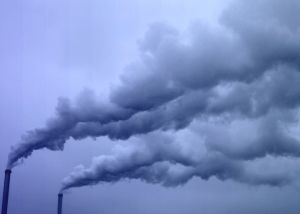 |
| Air pollution from China is traveling east to the United States. |
Climate-altering pollution from China is traveling across the Pacific Ocean and ending up on the West Coast of the United States, according to a new study published in the Journal of Geophysical Research. The particulate pollution, known as black carbon, absorbs sunlight and heats the upper atmosphere, possibly contributing to warmer spring temperatures along the U.S. coast. It arrives mostly in the form of soot and originates from automobile exhaust, agricultural burning, and other sources.
The black carbon traveling from Asia accounts for 77 percent of the black carbon emitted into North America’s lower atmosphere during the spring season, the study finds. Although the transported soot is only a small component of near-surface air pollution, it has a significant heating effect on the atmosphere two kilometers above the surface, especially in the Pacific region, which drives much of the Earth’s climate. “That’s the primary concern we have with these aerosols,” explained the study’s co-leader, Odelle Hadley with the Scripps Institution of Oceanography in San Diego, California. “They can really affect global climate.”
Previous studies along the U.S. West Coast have detected Asian pollution that contained dust from drought and deforestation as well as sulfur, soot, and trace metals from the burning of fossil fuels. On average, a new coal-fired power plant is built every week in China. Between 1954 and 2001 the amount of sunlight reaching the ground in China fell dramatically despite a decrease in regional cloud cover, a trend scientists attribute to worsening haze. Some experts predict that China may eventually generate one third of California’s air pollution.
More Resources:
“China and Her Coal,” January/February issue of World Watch magazine
This story was produced by
Eye on Earth,
a joint project of the Worldwatch Institute and the
blue moon fund. View
the complete
archive of Eye on Earth stories, or contact Staff Writer Alana
Herro at aherro [AT] worldwatch [DOT] org with your questions,
comments, and story ideas.